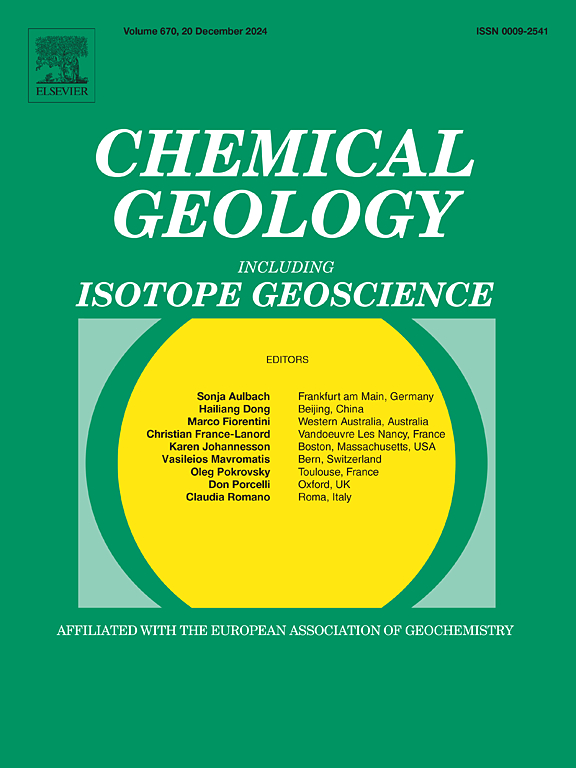地壳热状态控制着甘底斯带东部碰撞后富铜岩浆的形成
IF 3.6
2区 地球科学
Q1 GEOCHEMISTRY & GEOPHYSICS
引用次数: 0
摘要
碰撞后斑岩型铜矿床(PCDs)的成因仍有争议。冈底斯带东部碰撞后岩浆的铜富集表现出明显的变异性。人们普遍认为这些岩浆都是由下地壳部分熔融形成的,但其铜富性的机制尚不清楚。量化岩浆源中的热态和残余矿物比例,有助于了解富铜岩浆的地球动力学过程和形成条件。本文收集了始新世和中新世岩浆岩的地球化学资料,利用热力学模型和微量元素模型模拟了岩浆源的P-T-X (H2O)条件和矿物比例。结果表明,中新世岩浆源比始新世岩浆源具有更高的压力和水含量。相应的残余矿物组合也表现出由斜长石向石榴石、辉石向角闪石的过渡。这表明中新世地壳熔融带的加深和额外的水的加入。高压和高水条件有利于高铜富性碰撞后岩浆的形成。然而,高肥力可能不仅仅是由于下地壳中残留矿物(如石榴石和角闪孔)的影响,也可能部分继承自母体物质,母体物质已被先前的俯冲改变。这些因素可能是冈底斯带东部中新世出现强铜矿化的关键因素。研究结果为碰撞后斑岩型铜矿床的形成条件提供了定量约束。本文章由计算机程序翻译,如有差异,请以英文原文为准。
Crustal thermal state controls the formation of post-collisional Cu-fertile magmas in the eastern Gangdese belt
The genesis of post-collisional porphyry copper deposits (PCDs) remains debated. The post-collisional magmas in the eastern Gangdese belt exhibit significant variability in copper enrichment. There is broad consensus that all these magmas originated from lower crustal partial melting, yet the mechanisms driving their Cu fertility are unclear. Quantifying the thermal state and residual mineral proportion in magma sources may provide insight into geodynamic processes and the formation conditions of Cu-fertile magmas. Here, we compiled geochemical data for Eocene and Miocene magmatic rocks and simulated the P–T–X(H2O) conditions and mineral proportions of magma sources by using thermodynamic and trace element modeling. Our results indicate that the Miocene magma source exhibits higher pressure and H2O content compared to the Eocene magma source. The corresponding residual mineral assemblage also shows a transition from plagioclase to garnet and from pyroxene to amphibole. This implies the deepening of crustal melting zone and extra H2O addition during the Miocene. The high-pressure and high-water conditions favored the formation of highly Cu-fertile post-collisional magmas. However, the high fertility might not be solely attributed to the effects of residual minerals (e.g., garnet and amphibole) in the lower crust but might also be partially inherited from the parent materials, which have been modified by prior subduction. These factors could be crucial for the occurrence of strong copper mineralization during the Miocene in the eastern Gangdese belt. Our findings provide quantitative constraints for formation conditions of porphyry copper deposits in post-collision settings.
求助全文
通过发布文献求助,成功后即可免费获取论文全文。
去求助
来源期刊

Chemical Geology
地学-地球化学与地球物理
CiteScore
7.20
自引率
10.30%
发文量
374
审稿时长
3.6 months
期刊介绍:
Chemical Geology is an international journal that publishes original research papers on isotopic and elemental geochemistry, geochronology and cosmochemistry.
The Journal focuses on chemical processes in igneous, metamorphic, and sedimentary petrology, low- and high-temperature aqueous solutions, biogeochemistry, the environment and cosmochemistry.
Papers that are field, experimentally, or computationally based are appropriate if they are of broad international interest. The Journal generally does not publish papers that are primarily of regional or local interest, or which are primarily focused on remediation and applied geochemistry.
The Journal also welcomes innovative papers dealing with significant analytical advances that are of wide interest in the community and extend significantly beyond the scope of what would be included in the methods section of a standard research paper.
 求助内容:
求助内容: 应助结果提醒方式:
应助结果提醒方式:


